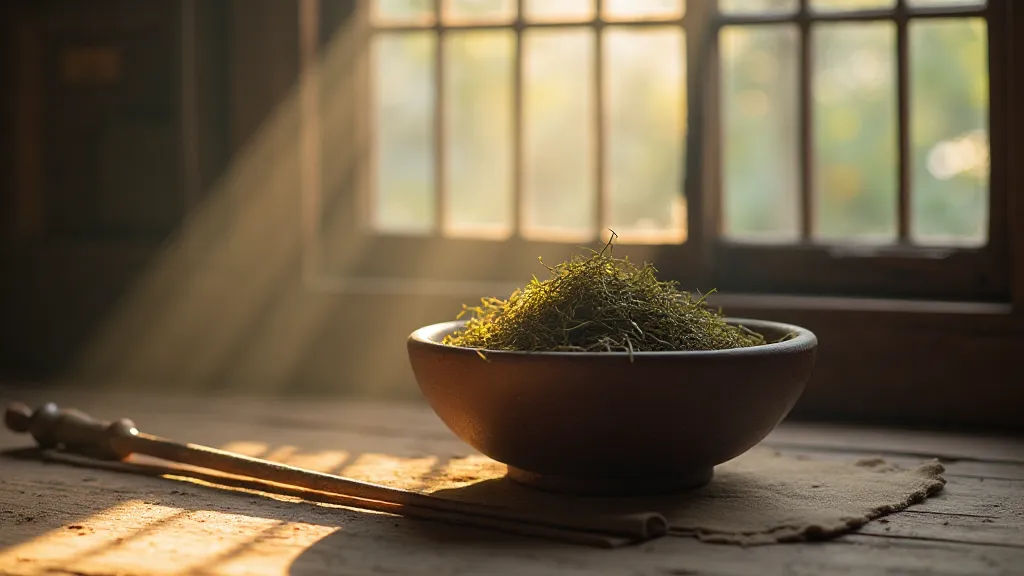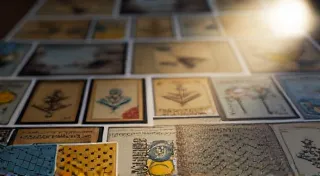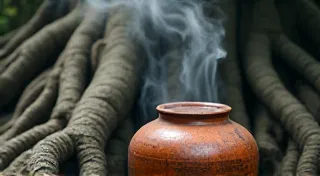Aromatic Incantations: The Ritualistic Uses of Mugwort Across Cultures
There's a certain magic held within the rustling leaves of an herb garden, a connection to ancient practices that hum just beneath the surface of our modern lives. Among these unassuming yet powerful plants, mugwort (Artemisia vulgaris) stands out, a humble weed to some, but a sacred herb to countless cultures throughout history. Its aroma, a complex blend of earthy bitterness and a surprising sweetness, instantly transports you – a fleeting glimpse into the worlds of dreamers, healers, and those who sought protection from unseen forces.
My own fascination with mugwort began years ago, while researching folklore remedies for insomnia. I'd read accounts of its use to induce vivid dreams, to journey into the realms of the subconscious. The simple act of burning a few dried leaves before sleep, the smoke curling upwards like a silent prayer, felt strangely significant. It wasn’t just about sleep; it was about opening a doorway.

A Dream Weaver's Herb: Dream Incubation and Prophecy
The association of mugwort with dreaming is arguably its most celebrated ritualistic use. Across Europe, and extending into Asia, cultures have utilized it to enhance dream states. The practice of “dream incubation,” where individuals consumed mugwort or burned it in their sleeping quarters, was common amongst the ancient Greeks. They believed that sleeping in a room suffused with mugwort's scent would allow them to receive messages from the gods. Prophetic dreams were highly valued, and the herb served as a conduit to divine knowledge.
The Romans also employed mugwort in similar ways, often placing it under pillows to ensure restful sleep and prophetic dreams. In some Celtic traditions, mugwort was burned to induce sleepwalking, believed to facilitate journeys into the Otherworld. The very name "Artemisia" itself, the scientific name for the genus containing mugwort, honors the Greek goddess Artemis, who was associated with the moon, dreams, and the wilderness—a fitting tribute to this potent herb.
Protection and Purification: A Shield Against Malevolence
Beyond the realm of dreams, mugwort held significant protective qualities. Its strong scent was believed to ward off insects and evil spirits. In many European cultures, it was traditionally hung over doorways and windows to guard against negativity. Farmers would stuff pouches of dried mugwort into their barns and fields to protect crops from pests and ensure a bountiful harvest.
Interestingly, the plant’s association with protection also stemmed from its perceived ability to reveal hidden dangers. Shamans and healers would sometimes chew mugwort to heighten their senses and discern the presence of malevolent energies. The bitter taste was believed to act as a deterrent, alerting the individual to any lurking threats. This protective association is evident in folk remedies, where it was used to treat bites from poisonous creatures and even to protect against witchcraft.
The Crossroads of Cultures: Mugwort in Asia and Beyond
The ritualistic uses of mugwort weren’t confined to Europe. Across Asia, particularly in China, Korea, and Japan, mugwort holds a place of reverence. In traditional Chinese medicine, it’s known as "ai ye," and is a key ingredient in moxibustion, a therapeutic technique involving the burning of dried herbs to stimulate acupuncture points. The heat and aroma are believed to dispel "cold" and promote circulation.

Korean folk medicine similarly utilizes mugwort for its warming properties, often incorporating it into footbaths to treat colds and improve circulation. In Japan, mugwort is essential in the "mugwort malting" process for sake production and is also used in the traditional “susuki” harvest festival, symbolizing the transition from summer to autumn and honoring ancestors. This widespread adoption underscores the herb’s inherent appeal and perceived benefits across diverse cultural landscapes.
The Art of Harvesting and Preparation
Harvesting mugwort is relatively straightforward, as it's often considered a weed and can be found growing wild in many regions. It thrives in disturbed soil, along roadsides, and in sunny fields. The best time to harvest is in late spring or early summer, when the plant is at its peak potency. Ensure you positively identify the plant before harvesting, as it can be confused with other species. Look for its distinctive aroma, fuzzy leaves, and characteristic silver markings.
Drying mugwort is crucial for preserving its medicinal and ritualistic properties. Simply hang the harvested stems upside down in a cool, dark, and well-ventilated area. Once completely dry, the leaves can be crumbled and stored in an airtight container. For dream work, burning a small amount of dried leaves is the most common method. For medicinal purposes, it can be brewed into teas or used as an ingredient in herbal preparations. Always consult with a qualified herbalist before using mugwort for medicinal purposes, especially if you are pregnant or breastfeeding.
The aroma itself is a story, a subtle narrative woven into the fabric of ancient practices. There’s a comforting bitterness that grounds you, a sweetness that lifts your spirits. It's a scent that evokes images of smoky fires, starlit nights, and the gentle wisdom of generations past. Handling mugwort isn't just an act of collecting a plant; it's engaging in a conversation with history.

Preserving the Legacy: A Respectful Approach
As we reconnect with the ancient wisdom embodied in herbs like mugwort, it's crucial to approach this practice with respect and a deep appreciation for the cultures that have revered it for centuries. Sustainable harvesting is paramount – taking only what you need and ensuring the plant’s ability to regenerate. Remember that these are not mere commodities but living links to our shared human heritage.
The ritualistic uses of mugwort offer a glimpse into the profound connection between humans and the natural world – a connection that, when rekindled, can enrich our lives and deepen our understanding of ourselves and the universe around us. May the aromatic incantations of mugwort continue to inspire dreams, offer protection, and guide us towards a more harmonious existence.





